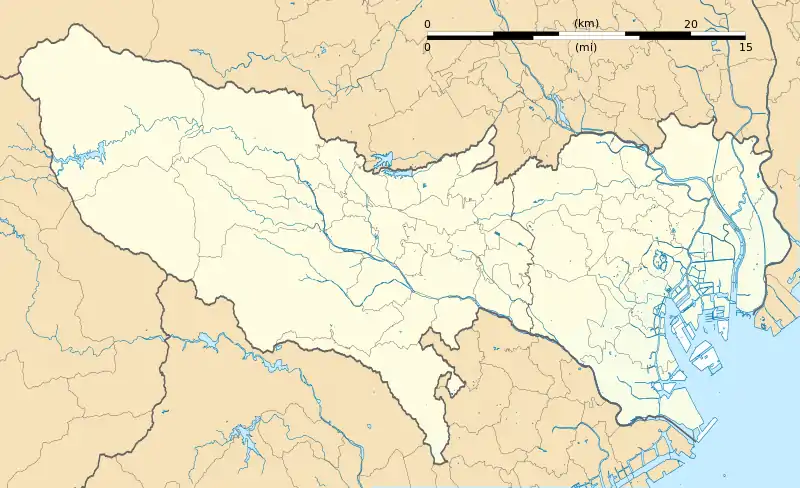Yūrakuchō Station
Yūrakuchō Station (有楽町駅, Yūrakuchō-eki) is a railway station in the Yūrakuchō district of Chiyoda, Tokyo, Japan, operated by East Japan Railway Company (JR East) and the Tokyo subway operator Tokyo Metro. It is Tokyo Metro's fifteenth busiest station in 2016.[1]

JK25 JY30 Y18 Yūrakuchō Station 有楽町駅 | |||||||||||||||||||||||||||||||
|---|---|---|---|---|---|---|---|---|---|---|---|---|---|---|---|---|---|---|---|---|---|---|---|---|---|---|---|---|---|---|---|
 Yūrakuchō Station Hibiya entrance in May 2017 | |||||||||||||||||||||||||||||||
| Location | Chiyoda-ku, Tokyo Japan | ||||||||||||||||||||||||||||||
| Operated by | |||||||||||||||||||||||||||||||
| Line(s) |
| ||||||||||||||||||||||||||||||
| Connections | C09 H08 I08 Hibiya Station | ||||||||||||||||||||||||||||||
| Other information | |||||||||||||||||||||||||||||||
| Station code | Y-18 JK-25 JY-30 | ||||||||||||||||||||||||||||||
| History | |||||||||||||||||||||||||||||||
| Opened | 25 June 1910 | ||||||||||||||||||||||||||||||
| Services | |||||||||||||||||||||||||||||||
| |||||||||||||||||||||||||||||||
| Location | |||||||||||||||||||||||||||||||
 Yūrakuchō Station Location within Special wards of Tokyo  Yūrakuchō Station Yūrakuchō Station (Tokyo)  Yūrakuchō Station Yūrakuchō Station (Japan) | |||||||||||||||||||||||||||||||
Lines
Yūrakuchō is served by the JR East Keihin-Tōhoku Line and Yamanote Line, and the Tokyo Metro Yurakucho Line subway. On Tokyo subway maps, nearby Hibiya Station is marked as an interchange and is linked to Yurakucho by underground passages.
Platforms
JR East Platforms
| 1 | JK Keihin-Tohoku Line | for Tokyo, Ueno, Akabane, and Ōmiya |
| 2 | JY Yamanote Line | for Tokyo, Ueno and Ikebukuro |
| 3 | JY Yamanote Line | for Shinagawa, and Shibuya |
| 4 | JK Keihin-Tohoku Line | for Shinagawa, Yokohama, and Ōfuna |
 Platforms 1 and 2
Platforms 1 and 2 Platforms 3 and 4
Platforms 3 and 4
Tokyo Metro Platforms
| 1 | Y Yurakucho Line | for Tsukishima, Toyosu and Shin-Kiba |
| 2 | Y Yurakucho Line | for Iidabashi and Ikebukuro TJ Tobu Tojo Line for Shinrinkoen |
 Yurakucho Line platforms
Yurakucho Line platforms
History

The elevated JR station opened on June 25, 1910. The subway station opened on October 30, 1974.
Chest-high platform edge doors were installed on the Yamanote Line platforms in July 2014, with operation scheduled to begin on 30 August 2014.[2]
Passenger statistics
In fiscal 2013, the JR East station was used by an average of 167,365 passengers daily (boarding passengers only), making it the fourteenth-busiest station operated by JR East.[3] In fiscal 2013, the Tokyo Metro station was used by an average of 158,809 passengers per day (exiting and entering passengers), making it the sixteenth-busiest station operated by Tokyo Metro.[4] The average daily passenger figures for each operator in previous years are as shown below.
| Fiscal year | JR East | Tokyo Metro |
|---|---|---|
| 1999 | 160,126[5] | |
| 2000 | 156,273[6] | |
| 2005 | 153,113[7] | |
| 2010 | 162,445[8] | |
| 2011 | 162,252[9] | 147,303[10] |
| 2012 | 164,929[11] | 152,102[12] |
| 2013 | 167,365[3] | 158,809[4] |
- Note that JR East figures are for boarding passengers only.
See also
References
- 各駅の乗降人員ランキング [Station usage ranking] (in Japanese). Tokyo Metro. Retrieved 23 May 2018.
- 山手線有楽町駅で可動式ホーム柵の設置工事 [Work to install platform edge doors at Yamanote Line Yurakucho Station]. Japan Railfan Magazine Online (in Japanese). Japan: Koyusha Co., Ltd. 2014-07-23. Retrieved 2014-07-24.
- 各駅の乗車人員 (2013年度) [Station passenger figures (Fiscal 2013)] (in Japanese). Japan: East Japan Railway Company. Retrieved 2 September 2014.
- 各駅の乗降人員ランキング [Station usage ranking] (in Japanese). Tokyo Metro. Retrieved 31 August 2014.
- 各駅の乗車人員 (1999年度) [Station passenger figures (Fiscal 1999)] (in Japanese). Japan: East Japan Railway Company. Retrieved 2 September 2014.
- 各駅の乗車人員 (2000年度) [Station passenger figures (Fiscal 2000)] (in Japanese). Japan: East Japan Railway Company. Retrieved 2 September 2014.
- 各駅の乗車人員 (2005年度) [Station passenger figures (Fiscal 2005)] (in Japanese). Japan: East Japan Railway Company. Retrieved 2 September 2014.
- 各駅の乗車人員 (2010年度) [Station passenger figures (Fiscal 2010)] (in Japanese). Japan: East Japan Railway Company. Retrieved 2 September 2014.
- 各駅の乗車人員 (2011年度) [Station passenger figures (Fiscal 2011)] (in Japanese). Japan: East Japan Railway Company. Retrieved 2 September 2014.
- 駅別乗降人員順位表(2011年度1日平均) [Station passenger figures (Fiscal 2011)] (in Japanese). Japan: Tokyo Metro. Retrieved 3 September 2014.
- 各駅の乗車人員 (2012年度) [Station passenger figures (Fiscal 2012)] (in Japanese). Japan: East Japan Railway Company. Retrieved 2 September 2014.
- 各駅の乗降人員ランキング (2012年) [Station usage ranking (2012)] (in Japanese). Tokyo Metro. Retrieved 2 September 2014.
External links
| Wikimedia Commons has media related to Yūrakuchō Station. |
